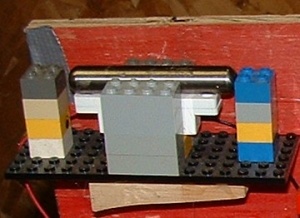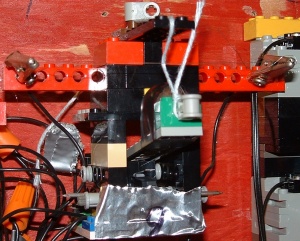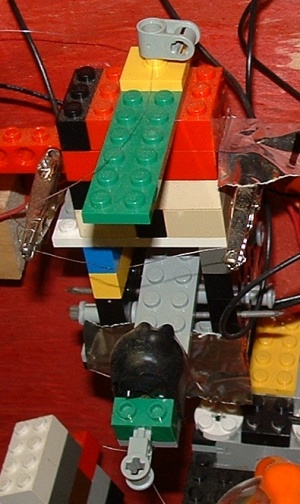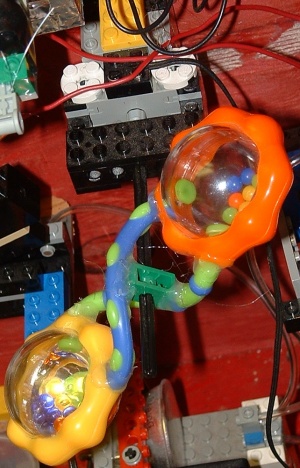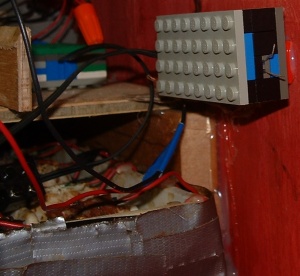2005 DarkSabre MPC
Articles in this series
The following is a list of pages pertaining to Mission Possible for Division C. Some of these pages may contain outdated information.
- Main Article
- Documented Devices
- Useful Components
- Year-Specific Information
This article documents a design not compatible with current event rules. |
2005 DarkSabre MPC
This is Dark Sabre's Energy Transfer List (ETL) from the 2005 National Tournament. Added on are two columns (Picture and Description) to help explain what is going on. The pictures here have been cropped significantly to help show exactly what is going on. Many more pictures are available on the gallery here.
Note that the rules for the ETL have changed every year and the below should not be considered an example for whatever the current rules are.
This machine was both successful and reliable at competition. It won my State competition and then placed 3rd at Nationals with a perfect score. I would change a few things about it if I went back, but not much.
The code for this device can be found here (DOCX file).
| No. | Action | Ending | Points | Bonus | Picture | Description |
| Magnet comes into contact with the magnetic sensor, opening a circuit | Elec | The starting task was to place/drop a magnet in the device. I dropped a cow magnet on a window security sensor (has a magnetic reed switch inside that toggles in the presence of a magnet). Bought it at Radioshack. | ||||
| 1 | Electromagnet is deactivated, dropping a ball (Electromagnet) | Mech | 10 | 15 | Electromagnet (magnet wire from Radioshack wrapped around a nail using a drill) drops a ball bearing into the seesaw. | |
| 2 | Ball tips seesaw, unblocking path between fiber optics and light sensor | Mech | 10 | |||
| Touch Sensor is activated, RCX begins the shoelace tying mechanism | Mech | The Nationals bonus, tying an overhand knot in a shoelace, was not required to trigger another action, so it was a "spur" off of the main line of transfers. The touch sensor is visible in the picture above just to the left of the pivot shaft. | ||||
| Shoelace is tied around a piston peg, which is then retracted | Mech | The motor in the center pulled the blue string, which was both looped into an overhand knot and tied onto the shoelace, so the string pulled the lace into a knot around the piston in the center. The piston could then raise and the knot was complete. | ||||
| Shoelace is pulled tight into an overhand knot (Ties overhand knot) | Mech | 100 | ||||
| 3 | Light sensor is activated by the light from the fiber optics | EMS | 10 | The shoelace spur is over and we are back to the main line of transfers. When the see saw pivoted, it exposed the light sensor to the light. | ||
| RCX switches motor on | ||||||
| 4 | Motor dumps washing soda (Na2CO3) into ferric chloride | Mech | 10 | This is an example of chemical precipitation, which was a bonus that year. I kept the darker half of the solution, the ferric chloride, in the test tube (which had the light beam passing through it to the light sensor) so that it was demonstrable that it was not the color of the two components separately, but the actual precipitation reaction that triggered the next transfer. I got the ferric chloride from my chem teacher and the washing soda from the grocery store. | ||
| 5 | Chemicals react to form an opaque precipitate (Precipitate) | Chem | 10 | 15 | ||
| Precipitate blocks the fiber optics light from light sensor | Mech | |||||
| 6 | Light sensor is activated by the absence of light | EMS | 10 | |||
| RCX switches motor on | ||||||
| Motor flips pneumatic switch | Mech | |||||
| Pneumatic piston pushes switch (Pneumatics) | Mech | 15 | There was a pneumatics bonus, which this satisfied. Piston extends and hits the microswitch. | |||
| Secondary piston activates tape player, playing the school name (School Name) | Mech | 50 | This was the State Bonus (counted at Nats too) and was also allowed to be a spur from the main line. The same switch that controlled the previous piston also extended this one, which started the tape player and played a recording over the speakers. | |||
| 7 | The switch completes a nichrome wire circuit | Elec | 10 | |||
| 8 | Nichrome wire heats, burning a string | Chem | 10 | An easy way to get a Chemical transfer was to burn something. I needed one, so I hooked up some Nichrome wire to burn string. String burns, weighted arm drops, and switch is depressed. | ||
| String releases a weight arm | Mech | |||||
| The weight arm depresses a switch | Mech | |||||
| 9 | The switch completes a nichrome wire circuit | Elec | 10 | |||
| 10 | Nichrome wire heats, melting a fishing line | Thermal | 10 | This is a carbon copy of the previous transfer, but as a Heat version, so this used a synthetic fishing line instead of thread. | ||
| Fishing line releases a weight arm | Mech | |||||
| The weight arm depresses a switch | Mech | |||||
| 11 | The switch completes a circuit | Elec | 10 | |||
| Fan is turned on, blowing ball upward | Mech | |||||
| Ball hovers in between fiber optics and a light sensor (Bernoulli) | Mech | 30 | One of the larger bonuses was to demonstrate the Bernoulli effect. This was probably one of the coolest bonuses in terms of all the different ways that people solved it. I used the part of the principle that states that faster moving air is at a lower pressure than slower moving air. This can be exploited to hover a ball over a fan. The ball is sitting on a column of low pressure moving air, but if it tries to leave the column, it encounters a "wall" of high pressure air. To ensure that my fan/ball arrangement was an absolute demonstration of the effect, the code that ran the machine required that the ball actually sit between the sensor and the light source for some time before the next transfer would happen. If the ball simply flew up and past the sensor and did not remain stable, the transfer would not continue. The fan was a mattress inflator, and was also the highest current drawing equipment in the machine. | |||
| 12 | Light sensor is activated by the absence of light | EMS | 10 | |||
| RCX switches motor on | ||||||
| Motor pulls a peg out of a spring while depressing another spring (Store Spring) | Mech | 30 | There were two spring related bonuses that year. One for storing energy in a spring (which was allowed to be a spur) and one for releasing energy from a spring. This setup did both at once. As the motor turned the gearbox, the piece with gears on top drew back and depressed the spring at the back, earning the Storing Energy bonus. At the same time, the other spring, which was held back by a peg in the moving piece, was released and pressed a microswitch. | |||
| First spring is released, depressing a switch (Release Spring) | Mech | 15 | ||||
| Water pump is activated, pushing water into a syringe | Mech | |||||
| The pressure of the water extends the syringe, pressing a switch (Hydraulics) | Mech | 15 | This was for the Mechanical Hydraulics bonus. A windshield wiper pump (from Autozone for ~$10) pumped water into a syringe, which extended and depressed a microswitch. Here, the syringe is shown extended. | |||
| 13 | Nichrome wire heats up a bimetallic strip | Thermal | 10 | |||
| Heat causes the metal to bend, depressing a touch sensor (Increasing Heat) | Mech | 15 | There were two related bonus here: Transfer cause by Increasing Heat and Transfer cause by Decreasing Heat. The latter appear on the ETL a few lines down, but I'll discuss it here. The Nichrome wire is wrapped around a bimetallic strip (from an outdoor dial thermometer). As the strip heats, the two metals expand at different rates, causing the strip to uncurl some. Here, it presses a lever (dark grey piece), which in turn presses a touch sensor (which is not really visible here). That touch sensor triggers the next transfer, which deactivates the Nichrome wire. This causes the bimetallic strip to return to its original position, releasing the lever and thus untriggering the touch sensor. Upon this untriggering, the next transfer (6 lines down) is triggered. | |||
| RCX switches motor on | ||||||
| Motor removes a plug and a lever falls, depressing a switch | Mech | There are three identical occurences of this transfer and they were all stacked on each other in the machine. The top one is shown already triggered and the middle one is shown untriggered. The motor turns an axle and pulls out a peg, allowing the ball bearing-weighted arm to depress a microswitch. | ||||
| Nichrome wire is deactivated | Elec | |||||
| 14 | The metal loses heat to the environment (Decreasing Heat) | Thermal | 10 | 15 | ||
| Bimetallic strip returns to its original position, releasing the touch sensor | Mech | |||||
| RCX switches motor on | ||||||
| Motor removes a plug and a lever falls, depressing a switch | Mech | |||||
| Piezoelectric buzzer is activated, releasing a piercing sound | Mech | A demonstration of the piezoelectric effect was one of the bonuses and, after experimenting with the type of piezo found in grill lighters, I settled on a piezo buzzer. The buzzer, which can be found online in surplus electronics stores or at RadioShack, emits quite an annoying, high pitch sound. This is detected by the microphone, which used to be a label mic before I spliced the wires into an RCX. If you are curious what the mic readouts look like, they appear on the Lego Programming page. | ||||
| Baby Rattle begins to shake (Shake a Baby Rattle for 10s) | Mech | 30 | A strange bonus: Shaking a baby rattle for at least 10 seconds (allowed to be a spur). Baby rattle + motor. Not much to explain. | |||
| Sound triggers a microphone (Piezoelectric Effect) | Elec | 30 | ||||
| RCX switches motor on | ||||||
| Motor removes a plug and a lever falls, depressing a switch | Mech | |||||
| Transformer circuit is completed, passing current through to LEDs (Transformer) | Elec | 30 | Use of a transformer was a bonus. The little green box on the left is a 1:1 transformer. Lacking an AC signal in the Mission box, I used a weather radio, which provided a working alternative. The green Lego box housed the LED that the radio powed via the transformer. The transformer is from Radioshack. | |||
| LEDs turn on, triggering a light sensor | EMS | |||||
| RCX switches motor on | ||||||
| Motor lowers a copper pipe into a vinegar solution with zinc | Mech | The first part of the Chemical Battery bonus, the copper pipe was lowered into a small vinegar jar to complete the battery. This was also where I manually adjusted time for how long the device would run. The higher up the pipe, which lowered very slowly, started, the longer the device ran. | ||||
| 15 | Anode, cathode, and acid react (Chemical Battery) | Chem | 10 | 15 | A vast improvement over the 2003 Mission, I used an ice cube tray with copper and zinc metal strips. I believe each side was in series with itself and in parallel with the other side. Regardless, it generated enough current to power the LED featured below. | |
| This reaction produces and electric current which passes to an LED | Elec | Low-current LED from Radioshack, housed in an enclosed Lego box. | ||||
| LED turns on, triggering a light sensor | EMS | |||||
| RCX switches motor on | ||||||
| Motor stretches a rubber band assembly which launches a ping pong ball | Mech | |||||
| Ping pong ball arches out of the box and then lands back inside | Mech | The final task was to launch a ping pong ball out of the box and then catch it. Timing stopped when the ping pong ball stopped moving. Both to keep the ball from bouncing back out and to quickly arrest further motion that could screw up my timing, I put some packing material in the catching dish. | ||||
| Other Bonuses: | ||||||
| Uses one electrical power source | 50 | A large bonus was available for powered the entire device from a single battery. I needed a number of different voltages, so I ran a couple of DC-DC transformers, but everything led back to that battery. | ||||
| Uses a single light source distributed through FO for the 3 scoring EMSs | 50 | Another large bonus was availible if every scoring EMS transfer derived its light from a single source. I used a very bright halogen bulb that illuminated three fiber optic cables, which led to the various EMS transfers. The fan was necessary to keep the bulb from melting the Legos and the fiber optics. |


